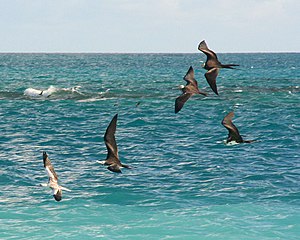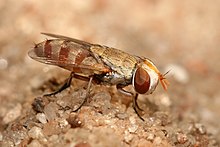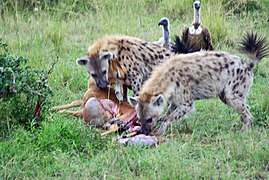
Parasitism is a close relationship between species, where one organism, the parasite, lives on or inside another organism, the host, causing it some harm, and is adapted structurally to this way of life. The entomologist E. O. Wilson characterised parasites as "predators that eat prey in units of less than one". Parasites include single-celled protozoans such as the agents of malaria, sleeping sickness, and amoebic dysentery; animals such as hookworms, lice, mosquitoes, and vampire bats; fungi such as honey fungus and the agents of ringworm; and plants such as mistletoe, dodder, and the broomrapes.

Seabirds are birds that are adapted to life within the marine environment. While seabirds vary greatly in lifestyle, behaviour and physiology, they often exhibit striking convergent evolution, as the same environmental problems and feeding niches have resulted in similar adaptations. The first seabirds evolved in the Cretaceous period, and modern seabird families emerged in the Paleogene.

Frigatebirds are a family of seabirds called Fregatidae which are found across all tropical and subtropical oceans. The five extant species are classified in a single genus, Fregata. All have predominantly black plumage, long, deeply forked tails and long hooked bills. Females have white underbellies and males have a distinctive red gular pouch, which they inflate during the breeding season to attract females. Their wings are long and pointed and can span up to 2.3 metres (7.5 ft), the largest wing area to body weight ratio of any bird.

In evolutionary ecology, a parasitoid is an organism that lives in close association with its host at the host's expense, eventually resulting in the death of the host. Parasitoidism is one of six major evolutionary strategies within parasitism, distinguished by the fatal prognosis for the host, which makes the strategy close to predation.
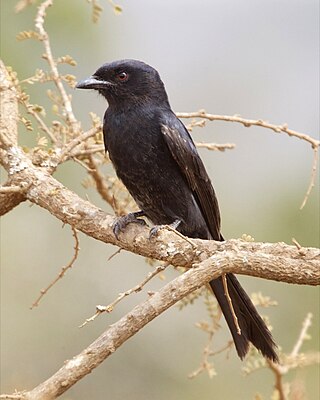
The fork-tailed drongo, also called the common drongo or African drongo, is a small bird found from the Sahel to South Africa that lives in wooded habitats, particularly woodlands and savannas. It is part of the family Dicruridae and has four recognized subspecies, D. a adsimilis, D. a. apivorus, D. a. fugax and D. a. jubaensis. Like other drongos, the fork-tailed is mostly insectivorous; its diet mainly consists of butterflies, termites, and grasshoppers.

Brood parasitism is a subclass of parasitism and phenomenon and behavioural pattern of certain animals, brood parasites, that rely on others to raise their young. The strategy appears among birds, insects and fish. The brood parasite manipulates a host, either of the same or of another species, to raise its young as if it were its own, usually using egg mimicry, with eggs that resemble the host's.

The great frigatebird is a large seabird in the frigatebird family. There are major nesting populations in the tropical Pacific Ocean, such as Hawaii and the Galápagos Islands; in the Indian Ocean, colonies can be found in the Seychelles and Mauritius, and there is a tiny population in the South Atlantic, mostly on and around St. Helena and Boatswain Bird Island.

The lava gull, also known as the dusky gull, is a medium-sized gull and a member of the "hooded gull" group. It is most closely related to the Laughing gull and Franklin's gull and is the rarest gull in the world. It is endemic to the Galapagos Islands.

The term cuckoo bee is used for a variety of different bee lineages which have evolved the kleptoparasitic behaviour of laying their eggs in the nests of other bees, reminiscent of the behavior of cuckoo birds. The name is perhaps best applied to the apid subfamily Nomadinae, but is commonly used in Europe to mean bumblebees Bombus subgenus Psithyrus. Females of cuckoo bees are easy to recognize in almost all cases, as they lack pollen-collecting structures and do not construct their own nests. They often have reduced body hair, abnormally thick and/or heavily sculptured exoskeleton, and saber-like mandibles, although this is not universally true; other less visible changes are also common.
An obligate parasite or holoparasite is a parasitic organism that cannot complete its life-cycle without exploiting a suitable host. If an obligate parasite cannot obtain a host it will fail to reproduce. This is opposed to a facultative parasite, which can act as a parasite but does not rely on its host to continue its life-cycle. Obligate parasites have evolved a variety of parasitic strategies to exploit their hosts. Holoparasites and some hemiparasites are obligate.
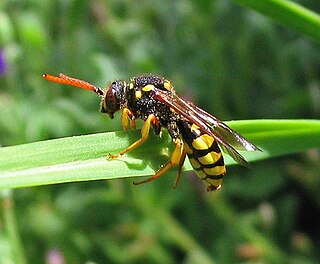
With over 850 species, the genus Nomada is one of the largest genera in the family Apidae, and the largest genus of cuckoo bees. Cuckoo bees are so named because they enter the nests of a host and lay eggs there, stealing resources that the host has already collected. The name "Nomada" is derived from the Greek word nomas, meaning "roaming" or "wandering."

Commonly known as cuckoo wasps or emerald wasps, the hymenopteran family Chrysididae is a very large cosmopolitan group of parasitoid or kleptoparasitic wasps, often highly sculptured, with brilliant metallic colors created by structural coloration. They are most diverse in desert regions of the world, as they are typically associated with solitary bee and wasp species, which are also most diverse in such areas. Their brood parasitic lifestyle has led to the evolution of fascinating adaptations, including chemical mimicry of host odors by some species.
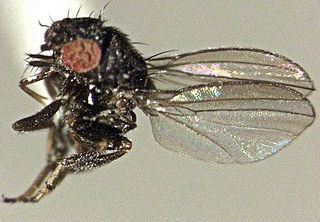
Milichiidae are a family of flies. Most species are very small and dark. Details of their biology have not yet been properly studied, but they are best known as kleptoparasites of predatory invertebrates, and accordingly are commonly known as freeloader flies or jackal flies. However, because of the conditions under which many species breed out, they also are known as filth flies.

Bombus bohemicus, also known as the gypsy's cuckoo bumblebee, is a species of socially parasitic cuckoo bumblebee found in most of Europe with the exception of the southern Iberian Peninsula and Iceland. B. bohemicus practices inquilinism, or brood parasitism, of other bumblebee species. B. bohemicus is a generalist parasite, successfully invading several species from genus Bombus. The invading queen mimics the host nest's chemical signals, allowing her to assume a reproductively dominant role as well as manipulation of host worker fertility and behavior.

A wasp is any insect of the narrow-waisted suborder Apocrita of the order Hymenoptera which is neither a bee nor an ant; this excludes the broad-waisted sawflies (Symphyta), which look somewhat like wasps, but are in a separate suborder. The wasps do not constitute a clade, a complete natural group with a single ancestor, as bees and ants are deeply nested within the wasps, having evolved from wasp ancestors. Wasps that are members of the clade Aculeata can sting their prey.

Bombus pensylvanicus, the American bumblebee, is a threatened species of bumblebee native to North America. It occurs in eastern Canada, throughout much of the Eastern United States, and much of Mexico.

The magnificent frigatebird is a seabird of the frigatebird family Fregatidae. With a length of 89–114 centimetres and wingspan of 2.17–2.44 m it is the largest species of frigatebird. It occurs over tropical and subtropical waters off America, between northern Mexico and Perú on the Pacific coast and between Florida and southern Brazil along the Atlantic coast. There are also populations on the Galápagos Islands in the Pacific and the Cape Verde islands in the Atlantic.
A facultative parasite is an organism that may resort to parasitic activity, but does not absolutely rely on any host for completion of its life cycle.
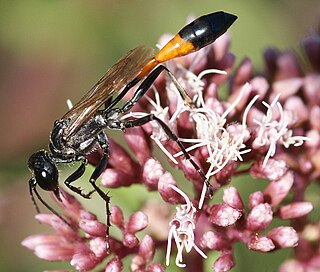
Ammophila sabulosa, the red-banded sand wasp, is a species of the subfamily Ammophilinae of the solitary hunting wasp family Sphecidae, also called digger wasps. Found across Eurasia, the parasitoid wasp is notable for the mass provisioning behaviour of the females, hunting caterpillars mainly on sunny days, paralysing them with a sting, and burying them in a burrow with a single egg. The species is also remarkable for the extent to which females parasitise their own species, either stealing prey from nests of other females to provision their own nests, or in brood parasitism, removing the other female's egg and laying one of her own instead.
Diptera is an order of winged insects commonly known as flies. Diptera, which are one of the most successful groups of organisms on Earth, are very diverse biologically. None are truly marine but they occupy virtually every terrestrial niche. Many have co-evolved in association with plants and animals. The Diptera are a very significant group in the decomposition and degeneration of plant and animal matter, are instrumental in the breakdown and release of nutrients back into the soil, and whose larvae supplement the diet of higher agrarian organisms. They are also an important component in food chains.
